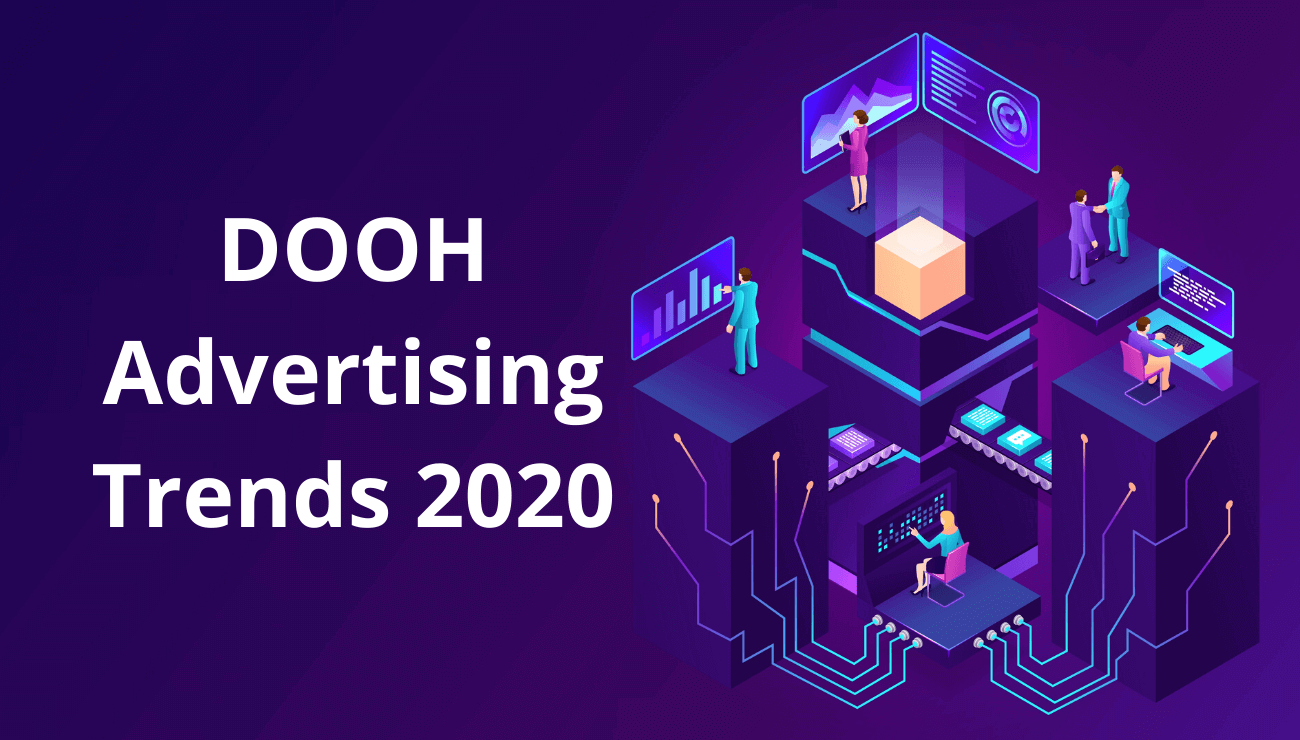Top 6 Digital Out-Of-Home Advertising Trends in 2020

1. The rise of programmatic DOOH: DOOH inventory is increasingly being sold programmatically, and this is set to become an industry-standard in the coming years bringing with it increased potential for integration with more extensive campaigns. By using computer programs to handle DOOH sales transactions, programmatic automation alleviates the need for negotiations with network owners on issues such as pricing and targeting, while also eliminating the need for laborious, manual scheduling of campaigns across a network.
By harnessing the ability to access an entire network inventory and book DOOH adverts at will, according to pre-established prices and criteria, media buyers are presented with a huge efficiency boost, while enjoying the flexibility to refresh creatives mid-way.
pDOOH is the way DOOH is going, not just because the technology makes it possible, but because it’s a very real need for media buyers to integrate every kind of media into a centralized, programmatic console.
2. Stronger links between mobile locational marketing and DOOH: this one is almost a no-brainer since mobile locational data marketing lends itself so well to a continued or extended brand experience with DOOH. For example, if a known customer enters a supermarket, it’s possible that not only will she receive offers and coupons based on her location, time of day, weather, etc. on her smart device, but also the creatives displayed on OOH media units can be personalized to her context, say in the aisle where she is standing at that moment.
3. Data-driven dynamic creatives: Improvements in real-time, data-driven audience targeting are forging a new category of ‘hyper-targeted’ programmatic ad placement. Creative play an important role in DOOH success. Creative overlaid with data to make it an even more powerful medium.
From DOOH display being able to read smart device data on the go to personalize creatives, to facial recognition and contextual advertising, DOOH is getting smarter by the day. With the racing technological advances with video, voice, AR/VR and the 5G revolution on its way, advertisers can expect real-time intelligence to feed DOOH units with the data it needs for campaign optimization on-the-fly.
4. More brands will use DOOH to deliver real omnichannel marketing: More and more brands appreciate the fact that DOOH is the only form of digital advertising that is beyond a consumer’s personal devices, thereby filling an important gap in brand engagement across multiple channels, devices, and platforms. With the emergence of digital signage kiosks that are compatible for use in-door and out-door, this trend is only expected to gain momentum.
For example, the Avengers movies by Marvel were promoted using one of the most omnichannel advertising campaigns in cinema. From online ads on YouTube, social media and search engines (all of which were compatible with any type of size of device) to TV, newspapers and – DOOH! NYC’s recently installed public internet hotspot’s ad screens lit up with Avenger commercials as people on pavements walked by. This is also followed by standard DOOH advertising on digital screens across subway entrances, inside local train screens (wherever available) and popular public squares. In other words, a true omnichannel advertising campaign definitely helped expand the Marvel and Avengers brands beyond their initial popularity and helped encapsulate newer audiences.
5. DOOH will compliment online and TV advertising: According to the 2012 report by Outdoor Advertising Association of America (OAAA), simply adding OOH advertising to your media mix can potentially increase the effectiveness of TV ads by 18% and of online ads by 316% (especially mobile). Today’s DOOH displays are far more immersive, innovative (such as roadside kiosks and displays with free wifi) and effective.
This is because, with a 98% audience reach using OOH (which is evolving to DOOH), these ads drive brand searches online. The most impulsive consumer action today is, Googling what they find interesting. It should be no surprise that public ads drive up online brand searches, and this has a cumulatively larger impact when combined with online and TV ads.
6. New DOOH platforms will increase ad effectiveness and improve metrics: As DOOH continues to gain in popularity and prevalence, its capabilities are improving to keep pace. As advertisers seek to increase engagement, screens are becoming increasingly interactive, with facial recognition, touch screens, and gamification helping to increase dwell time and improve brand awareness. The integration of QR codes on DOOH displays helps drive mobile traffic directly to specific landing pages.
Above, we showed how Avenger movie ads utilized public kiosks that are more than just another form of display, its a form of utility because those kiosks provide public hotspots within a range. The display size is also more of a human height, which makes the ad viewing experience more immersive, much like a TV screen. And these ads are actually being used by the government to fund these free public hotspots. Being connected to the internet these kiosks provide live ad impressions data to their demand-side platform’s dashboard for marketers to monitor in real-time.
Both the technology of DOOH and the monetary model of the business is evolving. Rather than just be a display of commercials, DOOH has the opportunity to add utility to the public who after all are their target audience.
To know more
- Email
- Phone+91 (011) 22412700
Subscribe to our newsletter
We understand you’re busy. But you still want to be informed. Join our community of more than 60,000 subscribers to stay up to date with the latest out-of-home media advertising trends and happenings in Edge1.
